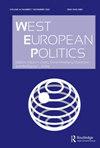Rebordering Europe in the Ukraine War: community building without capacity building
IF 3.6
1区 社会学
Q1 POLITICAL SCIENCE
引用次数: 3
Abstract
Abstract How has the European Union (EU) developed in reaction to the Russo-Ukrainian war, its most severe military threat since the end of the Cold War? In a ‘bordering’ analysis of political development, this article studies changes in the closure and control of the EU’s boundaries with Russia and Ukraine as well as its internal boundaries between 2013 and August 2022. It finds that the EU’s response has hitherto consisted in a regulatory process of community building without concomitant capacity building. Whereas the EU has increasingly closed its boundaries with Russia, it has progressively opened its boundaries towards Ukraine. By contrast, the war so far has not had a discernible impact on the EU’s internal boundary configuration and its authority and capacity for boundary control. These preliminary findings are in line with the EU’s developmental path as a ‘regulatory state’. More than half a year into the invasion, they stand in contrast to ‘bellicist’ expectations of centralised capacity building in response to military threats.在乌克兰战争中重新划定欧洲边界:没有能力建设的社区建设
摘要欧盟(EU)是如何应对自冷战结束以来最严重的军事威胁——俄乌战争的?在对政治发展的“边界”分析中,本文研究了2013年至2022年8月期间欧盟与俄罗斯和乌克兰边界及其内部边界的关闭和控制变化。它发现,迄今为止,欧盟的应对措施包括社区建设的监管过程,而没有相应的能力建设。尽管欧盟越来越多地关闭了与俄罗斯的边界,但它也逐渐开放了与乌克兰的边界。相比之下,到目前为止,这场战争尚未对欧盟的内部边界配置及其边界控制的权威和能力产生明显影响。这些初步发现符合欧盟作为“监管国家”的发展道路。入侵半年多后,他们与“好战主义者”对集中能力建设以应对军事威胁的期望形成了鲜明对比。
本文章由计算机程序翻译,如有差异,请以英文原文为准。
求助全文
约1分钟内获得全文
求助全文
来源期刊

West European Politics
POLITICAL SCIENCE-
CiteScore
10.00
自引率
7.10%
发文量
58
期刊介绍:
West European Politics (WEP)has established itself as one of the most authoritative journals covering political and social issues in Western Europe. It has a substantial reviews section and coverage of all national elections in Western Europe. Its comprehensive scope, embracing all the major political and social developments in all West European countries, including the European Union, makes it essential reading for both political practitioners and academics.
 求助内容:
求助内容: 应助结果提醒方式:
应助结果提醒方式:


